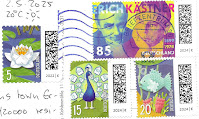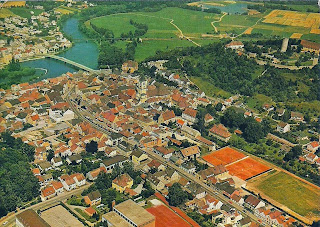Dießen am Ammersee
This is a project of collecting postcards from all over the world. Please send me postcards of your beautiful countries, states, islands, regions and subjects of interesting places, so I can feature them here.
Friday, November 14, 2025
Germany - Bavaria - Dießen am Ammersee
Dießen am Ammersee
Friday, September 19, 2025
Germany - Bavaria - Neuhaus an der Pegnitz
Tuesday, August 19, 2025
Germany - Bavaria - Garmisch-Partenkirchen
Germany - Bavaria - Großer Arber
Großer Arber mountain in the Bavarian Forest during winter.
Friday, August 15, 2025
Germany - Bavaria - Pilgrimage Church Maria Gern
Snow-covered Pilgrimage Church of Maria Gern, Berchtesgadener Land, Bavaria.
Wednesday, August 6, 2025
Germany - Bavaria - Allianz Arena
Allianz Arena
Allianz Arena (German: [aˈli̯ants ʔaˌʁeːna]; known as Munich Football Arena for UEFA competitions) is a football stadium in Munich, Bavaria, Germany, with a 70,000 seating capacity for international matches and 75,000 for domestic matches. Widely known for its exterior of inflated ETFE plastic panels, it is the first stadium in the world with a full colour changing exterior. Located at Franz-Beckenbauer-Platz 5 at the northern edge of Munich's Schwabing-Freimann borough on the Fröttmaning Heath, it is the second-largest stadium in Germany behind the Westfalenstadion in Dortmund.
Bayern Munich have played their home games at the Allianz Arena since the start of the 2005–06 season. The club had previously played their home games at the Munich Olympic Stadium since 1972. 1860 Munich previously had a 50 per cent share in the stadium, but, in 2006, sold this to Bayern for €11m to help resolve a serious financial crisis that saw 1860 facing bankruptcy. The arrangement allowed 1860 Munich to play at the stadium while retaining no ownership until 2025. However, in July 2017 Bayern terminated the rental contract with 1860, making themselves the sole tenants of the stadium (read more).
Friday, July 25, 2025
Germany - Bavaria - Augsburg Cathedral
Germany - Bavaria - Bad Tölz
Bad Tölz
Archaeology has shown continuous occupation of the site of Bad Tölz since the retreat of the glaciers at the end of the Ice Age. For example, there are finds from the Hallstatt culture as well as from Roman Raetia, or at least occupation by romanized Celts.
The name "Tölz" (as "Tolnze") appears relatively late in documentation at the end of the 12th century. The name "Reginried" appears as that of a settlement belonging to the monastery at Tegernsee in earlier texts, which is probably the same as Reid in the western part of Mühlfeld (read more).
Monday, July 14, 2025
Germany - Bavaria - Nymphenburg
Tuesday, June 24, 2025
Germany - Bavaria - Nuremberg (4)
Greetings From Nuremberg.
Friday, June 20, 2025
Germany - Bavaria - Aschaffenburg
Greetings From Aschaffenburg.
Sent by Sina from Bavaria, Germany.
Aschaffenburg (German pronunciation: [aˈʃafn̩bʊʁk]; Hessian: Aschebersch, pronounced [ˈaʒəˌbɛːʃ]) is a town in northwest Bavaria, Germany. The town of Aschaffenburg, despite being its administrative seat, is not part of the district of Aschaffenburg.
Aschaffenburg belonged to the Archbishopric of Mainz for more than 800 years. The town is located at the westernmost border of Lower Franconia and separated from the central and eastern part of the Regierungsbezirk (administrative region) by the Spessart hills, whereas it opens towards the Rhine-Main plain in the west and the north-west. Therefore, the inhabitants speak neither Bavarian nor East Franconian but rather a local version of Rhine Franconian (read more).
Wednesday, June 18, 2025
Germany - Bavaria - Franconian Switzerland
Greetings From Franconian Switzerland.
Sent by Jonas and Annett from Bavaria, Germany.
Franconian Switzerland (German: Fränkische Schweiz, pronounced [ˈfʁɛŋkɪʃə ˈʃvaɪts]) is an upland in Upper Franconia, Bavaria, Germany and a popular tourist retreat. Located between the River Pegnitz in the east and the south, the River Regnitz in the west and the River Main in the north, its relief, which reaches 600 metres in height, forms the northern part of the Franconian Jura (Frankenjura). Like several other mountainous landscapes in the German-speaking lands, e.g. Holstein Switzerland, Märkische Schweiz, or Pommersche Schweiz, Franconian Switzerland was given its name by Romantic artists and poets in the 19th century who compared the landscape to Switzerland. Franconian Switzerland is famous for its high density of traditional breweries (read more).
Germany - Bavaria - Würzburg Residence with the Court Gardens and Residence Square
Greetings From Würzburg
Cherry blossom in front of the Residenz.
Sent by Tom from Plauen in Saxony, Germany.
The Residence was essentially constructed between 1720 and 1744, decorated on the interior from 1740 to 1770 and landscaped with magnificent gardens from 1765 to 1780. It testifies to the ostentation of the two Prince-Bishops, and as such illustrates the historical situation of one of the most brilliant courts of Europe during the 18th century. The most renowned architects of the period - the Viennese, Lukas von Hildebrandt, and the Parisians Robert de Cotte and Germain Boffrand - drew up the plans. They were supervised by the official architect of the Prince Bishop, Balthasar Neumann, who was assisted by Maximilian von Welsch, the architect of the Elector of Mainz. Sculptors and stucco-workers came from Italy, Flanders, and Munich. The Venetian painter Giovanni Battista Tiepolo frescoed the staircase and the walls of the Imperial Hall.
Thursday, May 22, 2025
Germany - Bavaria - Erlangen
Greetings From Erlangen
Evening Market Square
Sent by Claudia from Erlangen, Germany.
Saturday, May 10, 2025
Germany - Bavaria - Town of Bamberg
Friday, May 9, 2025
Germany - Bavaria - Nuremberg (3)
Nuremberg - city view with Imperial Castle.
Sent by Heidi from Nuremberg, Germany
My other two postcards of Nurember are here, and here.
Germany - Neuschwanstein Castle (3)
Royal Castle Neuschwanstein, Germany.
Thursday, April 17, 2025
Germany - Augsburg
Sent by Ute from Augsburg, Germany.
Saturday, January 18, 2014
Germany - Bavaria - Munich - Oktoberfest
Munich
View of Oktoberfest
Sent by Birgit from Munich, Germany.
Octoberfest is the world's largest fair held annually in Munich, Bavaria, Germany. It is a 16-day festival running from late September to the first weekend in October with more than 6 million people from around the world attending the event every year. To the locals, it is often simply called "Wiesn", after the colloquial name of the fairgrounds (Theresienwiese) themselves. The Oktoberfest is an important part of Bavarian culture, having been held since 1810. Other cities across the world also hold Oktoberfest celebrations, modeled after the original Munich event. (read further)
Saturday, October 5, 2013
Germany - Bavaria - Burglengenfeld
Burglengenfeld
Sent by Ingrid, a WiP partner from Burglengenfeld, Germany.
Burglengenfeld is a town in the district of Schwandorf, in Bavaria, Germany. It is situated on the river Naab, 22 km north of Regensburg. (read further)








































